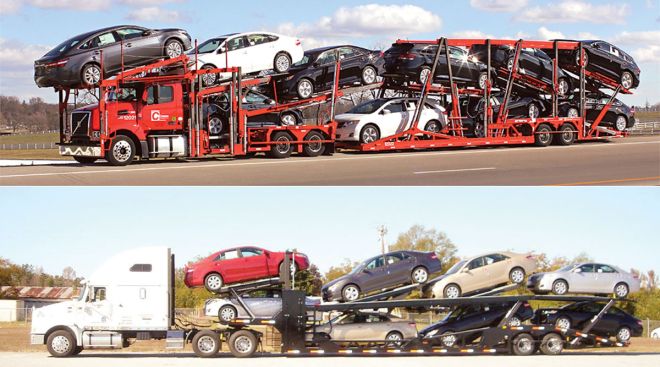Moving heavy equipment can be a daunting and challenging task. Whether you’re relocating your business or simply need to transport a large machine, the logistics involved in moving these hefty pieces of equipment can seem overwhelming. But fear not! In this blog post, we will explore the ins and outs of moving heavy equipment, including the tools and techniques used, as well as some valuable tips on how to ship backhoes and other massive machinery. So, if you’re curious about the cost and process of moving heavy equipment, buckle up and get ready for an informative ride! How do you move heavy equipment easily?
When it comes to moving heavy equipment, ease is the name of the game.
But how exactly do you make this seemingly arduous task easier?
Well, here are a few tips and tricks to help you navigate the process smoothly.
First and foremost, proper planning is key. Before you even attempt to move your heavy equipment, take the time to create a detailed plan that outlines every step of the process. This will not only save you time but also ensure that nothing gets overlooked or forgotten along the way.
Next, consider utilizing specialized tools and equipment designed specifically for moving heavy loads. Forklifts, cranes, and skid-steer loaders can be incredibly helpful in safely lifting and transporting bulky machinery. Invest in these tools or consider renting them if needed.
Furthermore, always prioritize safety when moving heavy equipment. Make sure all operators involved in the process are properly trained on how to handle large loads. Use appropriate safety gear, such as gloves and hard hats, when necessary.
Don’t underestimate the power of teamwork. Moving heavy equipment is often a collaborative effort that requires coordination between multiple individuals. Assign clear roles and responsibilities to each team member to ensure efficiency throughout the entire process.
By following these simple yet effective strategies for moving heavy equipment easily, you’ll be able to streamline your operations while minimizing potential risks or complications along the way.
What is used to move heavy equipment?
When it comes to moving heavy equipment, there are several tools and machinery that are commonly used. These specialized equipment helps make the task easier and more efficient. Let’s take a look at some of the most common tools used for moving heavy equipment.
One essential tool is a forklift. Forklifts come in various sizes and capacities, allowing them to lift and transport heavy loads with ease. They have sturdy forks that can be adjusted to fit different types of equipment.
Another commonly used tool is a crane. Cranes are often employed when dealing with extremely heavy or oversized equipment. They have a long boom that can extend vertically and horizontally, enabling them to lift heavy objects and move them over obstacles.
For smaller pieces of equipment or items that need precise positioning, skates or dollies may be utilized. Skates are low-profile platforms with wheels, allowing easy movement across smooth surfaces. Dollies provide stability and maneuverability when transporting bulky items.
In addition to these tools, straps, chains, and slings play an important role in securing the load during transportation. These devices ensure that the heavy equipment remains stable throughout the journey.
It’s worth noting that selecting the right tools depends on factors such as weight, size, shape, terrain conditions, and accessibility of the location where the equipment needs to be moved.
Moving heavy machinery requires careful planning and expertise to ensure safety while minimizing potential damage or delays during transit.
How do you ship a backhoe?
Shipping a backhoe might seem like a daunting task, but with the right approach and preparation, it can be done smoothly. The first step is to assess the size and weight of your backhoe to determine the appropriate shipping method. Depending on the distance and logistics involved, you may choose between trucking or flatbed transport.
Trucking involves hiring a carrier that specializes in heavy equipment transportation. They will use a lowboy trailer equipped with ramps to load and secure your backhoe safely. This method is ideal for shorter distances or when there are height restrictions along the route.
Flatbed transport is another option for shipping a backhoe. It involves securing the equipment onto an open flatbed trailer using chains, straps, or other specialized tie-downs. This method allows for flexibility in terms of route options and is suitable for longer distances.
Before shipping your backhoe, make sure to properly clean it and remove any loose or detachable parts. Inspect it thoroughly for any leaks or mechanical issues that need to be addressed before transportation.
Ensure that you have all the necessary permits and documentation required by state regulations or international customs, if applicable. By following these steps and working with experienced professionals in heavy equipment transportation, you can ship your backhoe safely and efficiently without breaking the bank!
How do I ship a large machine?
Moving heavy equipment can be a complex and expensive process. However, with the right knowledge and planning, it is possible to navigate this task smoothly. In this article, we have explored various aspects of moving heavy equipment, including how to move it easily, what tools are used for transportation, and how to ship specific types of machinery like backhoes.
When it comes to shipping a large machine, several factors determine the cost. The size and weight of the equipment play a significant role in determining the shipping method. For oversized or overweight machines, specialized carriers may need to be utilized.
Additionally, distance plays a crucial role in determining the overall cost of shipping heavy machinery. Longer distances require more fuel consumption and additional logistics arrangements, which can increase expenses.
Other considerations include insurance coverage for any potential damage during transit, as well as any necessary permits or licenses required by certain regions or countries.
To get an accurate estimate for shipping costs, it is recommended to contact professional transport companies specializing in moving heavy equipment. They will evaluate your specific requirements based on factors such as size, weight, distance traveled, and other logistical considerations before providing you with an estimate tailored to your needs.
In conclusion (without using those words), moving heavy equipment involves careful planning and expertise. It is important to consider various factors such as the size and weight of the machinery being moved, along with the distance traveled, when calculating expenses related to transporting these items securely from one location to another. By working closely with experienced professionals who specialize in handling heavy equipment moves, you can ensure that your valuable assets are transported safely while keeping costs within budget constraints.
Pros:
-It can save money and time for businesses that need to move heavy equipment
-It can help reduce the risk of damage to equipment during transit
-It can provide convenience and flexibility when dealing with large and bulky items
-It can be a cost-effective way to transport items long distances
Cons:
-It can be costly if the equipment is particularly heavy or difficult to transport
-It can be challenging to find a reliable and experienced heavy equipment mover
-There is always a risk of damage or loss during transit, so it is important to ensure that the right insurance coverage is in place
-It can take a long time and involve a lot of paperwork to get the necessary permits for large-scale equipment moves.
FAQs:
1. What is the average cost to move heavy equipment?
The average cost to move heavy equipment varies depending on the size and weight of the equipment, as well as the distance and type of transport required. Generally, you can expect to pay anywhere from a few hundred to several thousand dollars.
2. What factors affect the cost of moving heavy equipment?
The cost of moving heavy equipment is typically determined by its weight, size, and distance being transported, as well as any specialist requirements such as cranes or lifting platforms. Additional costs may be incurred for permits, insurance, and other related fees.
3. Is it cheaper to hire a professional mover or do it myself?
It depends on the size and weight of the equipment, as well as the distance and type of transport needed. If you have the necessary skills and experience to safely and securely move the equipment, then it may be more cost-effective to do it yourself.
4. What safety precautions should I take when moving heavy equipment?
When moving heavy equipment, it’s important to ensure that all safety procedures are followed. This includes wearing protective gear, using the proper tools, and securing the equipment properly in the transport vehicle. It’s also important to check the route before commencing travel to make sure there are no obstacles along the way.
5. Are there any additional costs associated with moving heavy equipment?
Yes, there may be additional costs associated with moving heavy equipment, such as permits, insurance, and fees for specialist services, such as cranes and lifting platforms. It’s important to factor these in when calculating your total moving cost.
Features:
1. Cost of Equipment Transport: Depending on the size and weight of the machinery, the cost of moving heavy equipment can vary significantly.
2. Distance of Move: The distance of the move will also be a factor when it comes to the cost of transporting heavy equipment. Longer distances will typically require a higher fee.
3. Size of Equipment: The size of the machinery being moved will be a major factor when it comes to the cost. Larger equipment will typically require more than one truck and could require specialized cranes and other equipment to complete the job.
4. Special Equipment and Tools: Some types of heavy equipment may require specialized tools and equipment in order to be moved safely. This could add to the cost of the move.
5. Type of Equipment: Different types of heavy equipment will require different methods of transport, such as flatbed trucks or heavy-duty trailers. This could affect the cost of the move.
6. Accessibility of the Location: The accessibility of the location where the equipment is being moved will also be a factor in the cost of the move. If the equipment has to be moved up or down stairs or through tight spaces, this could require additional labor and equipment, which will add to the cost.
7. Insurance: Insurance may also be a factor when it comes to the cost of moving heavy equipment. Insurance is typically required when transporting expensive or dangerous equipment and can add to the overall cost of the move.

